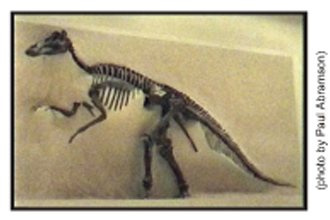DID HUMANS AND DINOSAURS CO-EXIST?
ACCORDING to evolution theory, dinosaurs became extinct about 70 million years ago, and no human being ever saw a live dinosaur. However, there is growing evidence that this theory is totally wrong, and that dinosaurs and humans have lived on earth together. In this factsheet, we shall consider some scientific and historical evidences which seriously challenge the popular view of dinosaurs.
FRESH DINOSAUR BONES
There have been numerous discoveries of fossilised dinosaur bones, and it has been argued that this is evidence that these creatures died millions of years ago. What is not widely known is that fresh, unmineralized dinosaur bones were discovered by a petroleum geologist in north-western Alaska in 1961. He assumed them to be bison bones, and it took scientists 20 years to recognise that the bones belonged to a duck-billed dinosaur, and that the deposit also contained the bones of large and small carnivorous dinosaurs, as well as horned dinosaurs.1 Scientists from the University of California and the University of Alaska are extracting the remaining fossils and facing a dilemma: how could these bones have remained in fresh condition for 70 million years? They were certainly not preserved by cold, because there is no doubt that the climate of the area was much warmer when the dinosaurs lived. This is indicated by the discovery of a 'buried forest' in the Canadian Arctic, which contained the unfossilized remains of redwood trees. It consisted of 50-metre-high trees, with 2-metre diameter trunks, which grew only about 6 metres apart (today only midget-sized plants can survive in that frozen wilderness). Although geologists claim the forest grew 45 million years ago, the wood can still be sawn, burned and even carved. An article in Canadian Geographic magazine reported: 'Walking among the ancient stumps and logs, it is easy to let imagination erase tens of millions of years, to step over not fossil, but freshly fallen trunks, [the wood] still has that reddish hue we often find in softwood lumber.'2 (emphasis added). The evidence suggests that the age of both the dinosaur bones and the buried forest is no more than a few thousand years, which is fatal to evolutionary theory.

Fossil of Edmontosaurus dinosaurus in the Smithsonian Museum.
NEW DATING METHODS
When we read the dinosaur bones have been dated radio-metrically as being “x” millions of years old, is not generally realised how these dates are obtained. Neither the fossils, nor the sedimentary rocks in which they are found can actually be dated radio-metrically. The dates are obtained from volcanic materials found near the fossils and these methods involve numerous unprovable assumptions.3
However, direct dating of dinosaur bones has been undertaken using the radio-carbon method — which is normally reserved for materials thought to be less than 50 thousand years old — and some amazing results were obtained. Bones of Acrocanthosaurus from Glen Rose, Texas, and bones of Allosaurus from Grand Junction, Colorado, yielded dates of 25,750 years and 16,120 years respectively!4 Further experiments undertaken in a Moscow laboratory by Russian scientists A. Ivanov and Dmitri Kouznetsov, using a new method known as Laser Mass Spectrometry, have confirmed that these fossils have a maximum age of 28,500 years.5 This places dinosaurs well within the time of modern man according to evolutionists' own dating. It must be pointed out, though, that radio-carbon dates are almost certainly far too high, and these dates could well be brought within the Biblical time-scale.6
HISTORICAL RECORDS
Stories of dragons abound in almost every culture, and it is reasonable to suppose that there is at least some truth in many of them, and that humans really have come face to face with great reptiles in the past. From Anglo-Saxon times, and even as late as the Middle Ages, numerous reports of sightings of dinosaur-like creatures have been preserved in historical records. Here is an example from a chronicle of 1405: 'Close to the town of Bures, near Sudbury (Suffolk), there has lately appeared, to the great hurt of the countryside, a dragon, vast in body, with a crested head, teeth like a saw, and a tail extending to an enormous length. Having slaughtered the shepherd of a flock, it devoured many sheep.'7 And from a chronicle that still survives in Canterbury Cathedral library we learn of a fight between two giant reptiles which took place on Friday, September 26th, 1449 in a riverside meadow near the village of Little Conrad on the Suffolk/Essex border. The fight was witnessed by the locals, and the field has been known as Sharpfight Meadow ever since.

Legends like that of George and the dragon may be based on fact.
The scientific and historical evidences seriously challenge the popular view that dinosaurs became extinct 60 million years before humans appeared. They point to the co-existence of humans and dinosaurs within historical times and expose the illusionary nature of the 'millions-of-years' evolutionary timescale.
REFERENCES:
- Journal of Paleontology, Vol. 61, No. 1, pp. 198-200.
- “Our Tropical Arctic” Canadian Geographic, Vol. 106, pp. 28-37 (1986/7).
- See The Dating Game, CRT Factsheet No. 49.
- L. Dahmer, et al in Proceedings of the 2nd International Conference on Creationism, Creation Science Fellowship Inc., Pittsburgh USA, pp. 371-374 (1990)
- A Ivanov & D. Kouznetsov, in a paper presented at the 5th European Creationist Congress, 1992.
- See Does Radio-carbon Dating disprove the Bible? AIG Booklet obtainable from CRT (50p)
- Bill Cooper, 'Living Dinosaurs from Anglo-Saxon and Other Early Records', Ex Nihilo Technical Journal, Vol. 6, Pt. 1, pp. 49-66 (1992).
Factsheets published regularly by Creation Resources Trust P.O. Box 3237, Yeovil, BA22 7WD
(Registered charity No 1016666) www.c-r-t.co.uk © 2003

